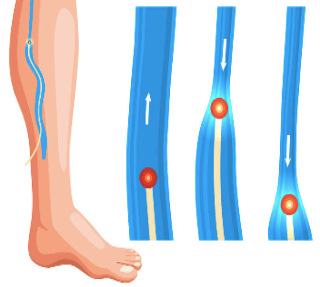
Medically Reviewed By Dr. Karan Anandpara Updated on November 1, 2024
Endovenous means from inside the veins. Therefore EVLT means ablating or burning the veins from inside using Laser. EVLT is considered as gold standard for the treatment of varicose veins.

There are two types of veins in your leg – the superficial and deep venous system. Blood flows from the superficial to the deep system and then to the heart. There are valves connecting the superficial and deep veins. In patients with varicose veins, these valves and perforators are damaged, causing blood to flow in the reverse direction from the deep to the superficial venous system. Therefore blood starts pooling in your legs.
This causes symptoms like pain, heaviness, discolouration or in severe cases venous ulceration. Earlier, the treatment of Varicose Veins involved stripping or ligation and surgical excision and removal of these superficial veins. However, open surgical procedures had its own set of complications with a longer recovery time and a much higher rate of recurrence. Therefore currently the gold standard of treatment of Varicose Veins is laser ablation.
The principle of EVLT involves burning of these superficial veins i.e the great & short saphenous vein and foam sclerotherapy of the superficial varicosities. Unlike surgical open stripping, in EVLT, using heat generated through the laser fibre, the veins are ablated. Over a period of time these veins becomes fibrous, thin and cord-like and serve no function. This causes the resolution of symptoms since there is no longer any pooling of blood.
No, all Varicose Veins do not require treatment. However, they do require monitoring and management. Only symptomatic Varicose Veins that causes symptoms like pain, heaviness, pigmentation or venous ulcer require treatment. Early grade Varicose Veins can also be controlled with compression stockings only.
Only severe varicose veins and those causing symptoms require EVLT. Before undergoing EVLT, your doctor may advise you for a trial of conservative management in the form of stockings only. Before undergoing EVLT it is also important to rule out secondary Varicose Veins i.e other causes of venous insufficiency like chronic deep venous insufficiency, may thurner syndrome, pulmonary hypertension and/or other cardiac causes of venous insufficiency.
Latest advances in Endovenous Laser Ablation
Earlier, the 1470 nm laser Fibre was available. However, the latest 1940 nm laser Fiber is now available. Post procedure pain, bruising and numbness is much lesser with the 1940 nm laser Fiber as compared to the 1470 nm laser.
Which doctor will be performing EVLT?
Image guided procedures require specialists doctors called Interventional Radiologists (IR). These are specially trained medical professionals who performs image guided vascular procedures.
Closure rate of the Great Saphenous Vein (GSV) or the Small Saphenous Vein (SSV) using laser is around 96 to 97%. In 3% of cases, the GSV once closed may open up again. This most likely happens either due to in adequate ablation or technique or if stockings are not adequately worn post procedure.
For foam sclerotherapy the chances of reopening of the superficial varicosities is between 27 to 30%. It is important to note that the superficial varicosities are only of cosmetic concern. They do not have any medical significance. It is the closure of the main venous channel i.e. the GSV and the SSV closure by laser that is important.
About Foam Sclerotherapy
EVLT involves closing the main long venous channel called the GSV or the SSV. However for the superficial tortuous venus varicosities, a special injection may have to be given to close them. This procedure is done using a special drug called sodium tetradacyl sulphate or STS. The procedure of closing the superficial varicosisties using STS is called foam sclerotherapy.
EVLT is a daycare procedure. All routine activities can be continued from the next day. Some amount of pain and bruising is expected for around 3 to 4 weeks. However with adequate medication, this pain and bruising is also manageable. All routine activities can be continued within a day or two after the procedure. No bed rest is required after the procedure.
Potential Complications of Endovenous Laser Ablation Procedure?
EVLT is an extremely safe procedure if done in the correct patient and in the correct manner. After the procedure mild bruising and pain is expected for around 3 to 4 weeks. However, this usually settles with medication and ice packs. One of an extremely, rare but dreaded complication of EVLT is deep vein thrombosis. However when done under the complete guidance of ultrasound by a well-trained interventional radiologist, the chances of DVT are almost negligible.
Class II Thigh High compression stockings are to be worn after the procedure. They do not have to be removed for the first 48 hours. After that, they need to be worn on a daily basis and removed at night for the next six months. The purpose of stockings is to give external compression so that the veins which have been burnt and ablated remain closed and do not open up again. After six months, you will be asked to shift to below knee stockings or support socks as a preventive measure.